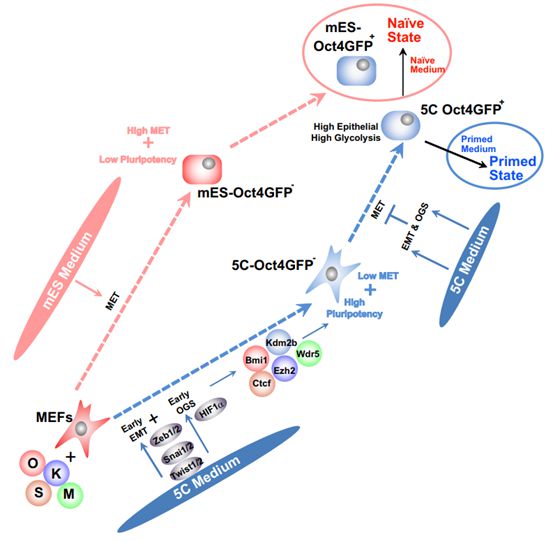Study Reveals New Mechanism for Regulation of Somatic Pluripotency
A group of scientists from the Guangzhou Institute of Biomedicine and Health (GIBH), Chinese Academy of Sciences recently found a new mechanism that metabolism and epithelial-mesenchymal transformation coordinate to regulate somatic reprogramming.
Results of the study were published online on February 24th, in the international academic journal The EMBO Journal, entitled “Metabolic switch and epithelial–mesenchymal transition cooperate to regulate pluripotency”.
Epithelial and interstitial states are the two main cellular states. Multicellular organisms form complex structures through repeated cell transitions between epithelial and mesenchymal states. Epithelial-mesenchymal transition (EMT) and mesenchymal-epithelial transition (MET) are involved in various biological processes.
MET is an important early stage of fibroblast reprogramming, and the introduction of transient EMT before normal MET can effectively improve reprogramming efficiency. Such sequential EMT-MET plays an important role in many cell fate determination and conversion processes, but the specific regulatory mechanism is not clear.
Dr. ZHENG Hui and his team at GIBH used a new medium (5C medium) to induce EMT early in the reprogramming of fibroblasts and proved that early EMT can effectively promote the process of pluripotency reconstruction.
Early EMT can effectively promote the transformation of cellular energy metabolism pattern from oxidative phosphorylation to glycolysis (OGS). Early induction of OGS using small molecules or transcription factors in early reprogramming can also be observed EMT.
Further research indicates that early EMT and OGS form a positive feedback loop through transcriptional activation between key downstream transcription factors. “In the early stages of reprogramming, EMT and OGS together activate a series of epigenetic regulatory factors through downstream transcription factors,” said ZHENG.
Up-regulating the expression of these factors can activate the expression of core pluripotency transcription factors and effectively promote the process of pluripotency reconstruction, according to the study. The researchers also verified the correlation between early EMT and OGS in the subsequent differentiation of embryonic stem cells into liver cells and glial cells into nerve cells.
“Given the important role of epithelial-mesenchymal transformation and energy metabolism in tumor genesis and development, this study may provide a new perspective for tumor research,” said ZHENG.
This work was supported by the Strategic Priority Research Program of Chinese Academy of Sciences (Grant No. XDA16010305), the Key Research Program of Frontier Sciences of Chinese Academy of Sciences (Grant No. QYZDB-SSWSMC031), the National Natural Science Foundation of China (Grant No.U1601228, 31671475, 31421004, 31900699, and 81702445), the Key and Development Program of Guangzhou Regenerative Medicine and Health Guangdong Laboratory (Grant No. 2018GZR110104008), and the Science and Technology Planning Project of Guangdong Province (Grant No. 2017B030314056).

Schematic illustration of current results. (Image by ZHENG Hui’s team)
Attachment Download:
-
Contact
-
Reference
-
Related Article